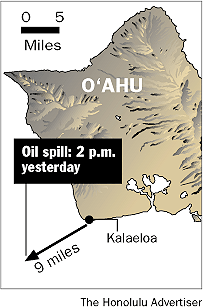By James Gonser
Advertiser Leeward Bureau
KALAELOA — The 630 gallons of crude oil that spilled into the ocean off Kalaeloa on Sunday morning have not been totally contained, but no birds, animals or humans are endangered as the slowly dissipating oil is pushed out to sea by trade winds, according to officials at the Hawai‘i Oil Spill Response Center.
Coast Guard Capt. Gilbert Kanazawa said the oil spilled at about 7:15 a.m. Sunday during routine unloading operations at Tesoro Hawai‘i’s mooring site 1 1/2 miles from shore. As of yesterday afternoon, what remained of the slick had drifted about nine miles southwest of Kalaeloa, away from O‘ahu and Kaua‘i, Kanazawa said.
Curtis Martin, the state Health Department’s emergency response preparedness coordinator, said the oil is being watched from helicopters, ships following the spill and by crews walking along Leeward beaches checking for oil that may have washed ashore.
"At this point there are no indications of any damage to the environment, wildlife or sea mammals," Martin said. "Our concern is to make sure that doesn’t happen."
F. David Hoffman, manager of environmental affairs and emergency preparedness for Tesoro Hawai‘i, apologized for the spill during a briefing yesterday at the response center.
"Tesoro regrets the incident occurred and pledges to do anything we can to clean up the spill to the satisfaction of the Coast Guard and the state," Hoffman said.
This is the second time Tesoro has spilled oil from its mooring site. The first spill in 1998 involved more than 100 barrels of oil, or about 4,200 gallons, and was significantly larger than Sunday’s spill. That spill was caused by a cut transfer line at the mooring and resulted in "tar balls" washing up on miles of Kaua‘i’s shoreline.
In the latest incident, the tanker Overseas Chicago was moored offshore unloading its 600,000 barrels of crude oil through hoses and undersea pipelines to a Tesoro refinery at Kalaeloa when a coupling separated from a hose, spilling oil for less than five seconds, Hoffman said. Tesoro uses this process to unload about 33 million barrels of oil a year.
The hose coupling has a built-in safety feature that closes off the hose in the event of a disconnection, stopping the flow of oil, he said. The section of hose connected to the tanker was lifted from the water and the coupling that separated is being inspected to determine why it failed.
Emergency response teams were deployed, and containment barriers, a skimmer and absorbent material were used to collect as much oil as possible. Dispersants also were used for the first time in Hawai‘i to break down the oil. Dispersants are materials used to accelerate the natural breakdown of the oil into droplets.
Martin said after nightfall Sunday a floating marker buoy was dropped into the oil slick and the 130-foot emergency response vessel Clean Islands stayed out all night tracking the spill.
"We are doing everything we can to track it and anything we find that we can (use) to dispose or collect it," Martin said. "However, based on reports from the helicopter as well as the vessel, we are seeing so light of a sheen they are not able to do anything. Basically it will burn off with the sun."
[back to top] |

